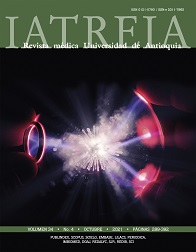Chronic lymphocytic Leukemia and deletion of the TP53 gene: Case report and literature review
DOI:
https://doi.org/10.17533/10.17533/udea.iatreia.115Keywords:
genes, p53, case reports, leukemia, lymphocytic, chronic, B-cellAbstract
Genetic alterations in the TP53 gene are present in 5 to 8% of chronic lymphocytic leukemia (CLL) cases at the time of diagnosis. These cases are typically associated with poor prognosis due to their resistance against standard CLL treatment. In our report a 52-yearold male patient was diagnosed with CLL, CD38 expression and a deletion in the TP53 gene (17p13.1). Upon evaluation post-treatment, minimal residual disease (MDR) was observed, and a haploidentical stem cell transplant was performed. Because of the high risk of relapse, his age, and the absence of comorbidities it was the only curative option to date for CLL. The purpose of this article is to complete a literature review that will give a basis to analyze the clinical case presented, within the framework of the clinical implications, prognosis, and response to treatment in patients with CLL who present with aberrations of the TP53 gene.
Downloads
References
(1) Hallek M. Chronic lymphocytic leukemia: 2020 update on diagnosis, risk stratification and treatment. Am J Hematol. 2019;94(11):1266–87. DOI 10.1002/ajh.25595.
(2) Campo E, Swerdlow SH, Harris NL, Pileri S, Stein H, Jaffe ES. The 2008 WHO classification of lymphoid neoplasms and beyond: Evolving concepts and practical applications. Blood. 2011;117(19):5019–32. DOI 10.1182/blood-2011-01-293050.
(3) Enciso L, Rodríguez M, Garcia J del S, Rosales J, Duque JE, Abello V, et al. Consenso Colombiano sobre el tratamiento de la Leucemia linfocítica crónica. Rev colomb cancerol. 2006;3341111(9):36–49.
(4) Scarfò L, Ferreri AJM, Ghia P. Chronic lymphocytic leukaemia. Crit Rev Oncol Hematol. 2016;104:169–82. DOI 10.1016/j.critrevonc.2016.06.003.
(5) Rafei H, Kharfan-Dabaja MA. Treatment of Del17p and/or aberrant TP53 chronic lymphocytic leukemia in the era of novel therapies. Hematol Oncol Stem Cell Ther. 2018;11(1):1–12. DOI 10.1016/j.hemonc.2017.04.002.
(6) Yuan YY, Zhu HY, Wu JZ, Xia Y, Liang JH, Wu W, et al. The percentage of cells with 17p deletion and the size of 17p deletion subclones show prognostic significance in chronic lymphocytic leukemia. Genes Chromosom Cancer. 2019;58(1):43–51. DOI 10.1002/gcc.22692.
(7) Hallek M, Cheson BD, Catovsky D, Caligaris-Cappio F, Dighiero G, Döhner H, et al. iwCLL guidelines for diagnosis, indications for treatment, response assessment, and supportive management of CLL. Blood. 2018;131(25):2745–60. DOI 10.1182/blood-2017-09-806398.
(8) El-Kinawy NS, Sharaf HM, El-Hamid MA. Prognostic significance of del 17p, ZAP-70 and CD38 as independent indicators for B-CLL: Correlation to response to treatment and disease outcome. Egypt J Med Hum Genet. 2012;13(2):173–81.
(9) Zhou Y, Tang G, Medeiros LJ, McDonnell TJ, Keating MJ, Wierda WG, et al. Therapy-related myeloid neoplasms following fludarabine, cyclophosphamide, and rituximab (FCR) treatment in patients with chronic lymphocytic leukemia/small lymphocytic lymphoma. Mod Pathol. 2012;25(2):237–45. DOI 10.1038/modpathol.2011.158.
(10) Rodrigues CA, Gonçalves MV, Ikoma MRV, Lorand-Metze I, Pereira AD, Farias DLC de, et al. Diagnosis and treatment of chronic lymphocytic leukemia: recommendations from the Brazilian Group of Chronic Lymphocytic Leukemia. Rev Bras Hematol Hemoter. 2016;38(4):346–57. DOI 10.1016/j.bjhh.2016.07.004.
(11) Molica S, Matutes E, Tam C, Polliack A. Ibrutinib in the treatment of chronic lymphocytic leukemia: 5 years on. Hematol Oncol. 2020;38(2):129–36. DOI 10.1002/hon.2695.
(12) Bohorquez L, Abello V, Solano MH, Casas C, Espinosa D, León G. Ibrutinib for Chronic Lymphocytic Leukemia (CLL): A Single Center Experience in Bogotá, Colombia. Clin Lymphoma Myeloma Leuk. 2019;19(September):S285. DOI 10.1016/j.clml.2019.07.225.
(13) Kovacs G, Robrecht S, Fink AM, Bahlo J, Cramer P, Von Tresckow J, et al. Minimal residual disease assessment improves prediction of outcome in patients with chronic lymphocytic Leukemia (CLL) who achieve partialresponse: Comprehensive analysis of two phase III Studies of the German CLL Study Group. J Clin Oncol. 2016;34(31):3758–65. DOI10.1200/JCO.2016.67.1305.
(14) Hill BT, Ahn KW, Hu Z, Aljurf M, Beitinjaneh A, Cahn J, et al. Assessment of Impact of HLA Type on Outcomes of Allogeneic Hematopoietic Stem Cell Transplantation for Chronic Lymphocytic Leukemia. Biol Blood Marrow Transplant. 2018 Mar;24(3):581-586. DOI 10.1016/j.bbmt.2017.10.015.
Published
How to Cite
Issue
Section
License
Copyright (c) 2021 Universidad de Antioquia

This work is licensed under a Creative Commons Attribution-NonCommercial-ShareAlike 4.0 International License.
Papers published in the journal are available for use under the Creative Commons license, specifically Attribution-NonCommercial-ShareAlike 4.0 International.
The papers must be unpublished and sent exclusively to the Journal Iatreia; the author uploading the contribution is required to submit two fully completed formats: article submission and authorship responsibility.














